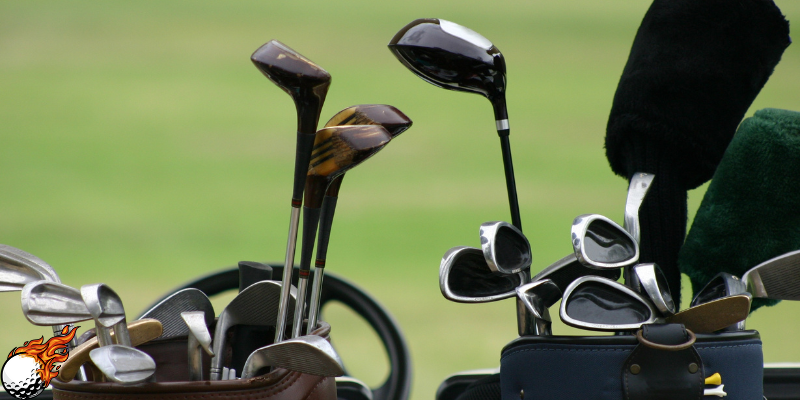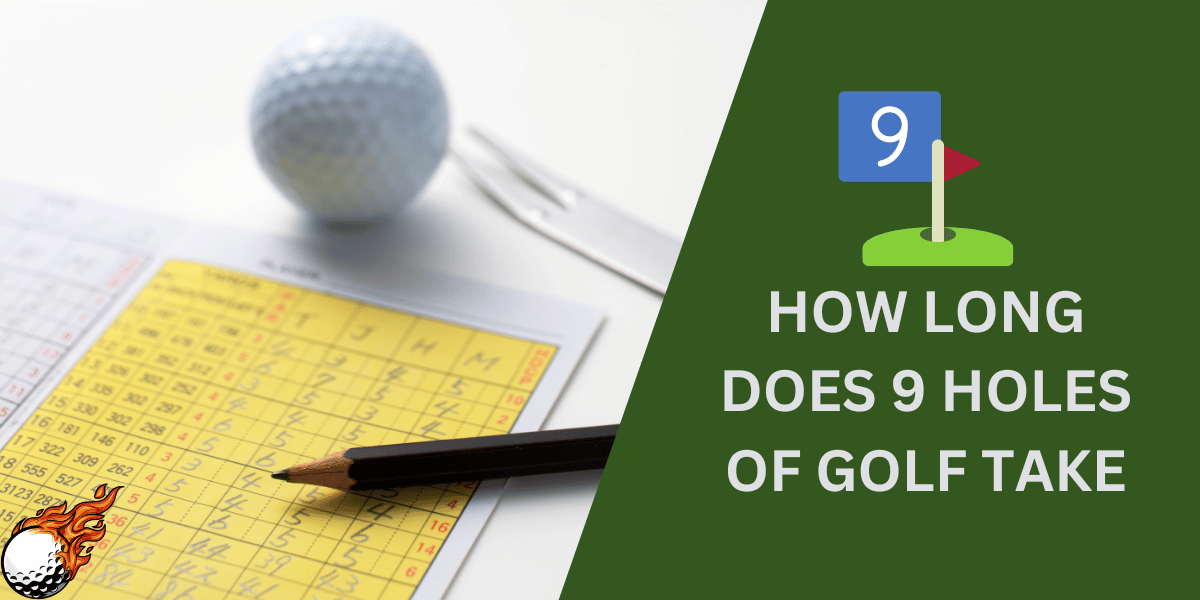
Have you ever hit a golf ball that barely goes anywhere?
Maybe it’s not your swing, but your clubs!
Using the right length golf clubs can seriously help your game.
Imagine swinging a club that’s too short – you’ll be bent over and hitting weak shots.
You’ll be reaching and likely slicing the ball all over the place.
That’s why getting the proper club length is crucial. This guide will show you how to measure your golf clubs, understand what those measurements mean, and explain why it all matters.
Golf Club Measurement Basics
- Setup: Place your club on a flat surface like you’re about to hit a shot (club head resting on the ground).
- Ruler Time: Slide a 48-inch golf ruler along the backside of the shaft. The bottom of the ruler should touch the ground next to the club’s heel.
- Get Your Number: Look where the ruler lines up with the very top of the grip. That number (in inches) is the length of your golf club.
Example: Your 7-iron measures 37 inches. A standard 7-iron is usually 37.5 inches. This means your club might be slightly shorter than the typical standard.
Remember: Clubs can be adjusted! Pros can measure other factors for the perfect fit.
Why Measure Your Clubs?
You might think all golf clubs are the same, but there can be tiny differences, even within a standard set.
Over time, your body can change, meaning those perfect clubs from last year might not be so perfect now.
That’s why it’s smart to learn how to measure them yourself!
Golf club manufacturers use “golf club length charts” for standard sizes, but the best way to get the perfect fit is to measure.
What Does “Proper Length” Mean?
Getting the “proper length” means your club isn’t too long or too short for you.
When you stand in your golf stance with your arms hanging straight, there should be a tiny gap between the club head and the ground.
Pros do “club fitting” for perfect sizing, but learning to measure is step one!
It’ll show if your clubs are off. Most golf clubs can be adjusted slightly if needed, and women’s golf clubs are usually a bit shorter to start with.
Standard Method for Measuring Golf Club Length

Alright, measuring your golf club is super simple!
You’ll need:
- Your golf club (any type will work)
- A flat surface (floor works great)
- A special 48-inch golf club ruler (or a measuring tape)
Here’s what to do
- The Setup: Put your club on the floor like you’d use it to hit a ball. Let the bottom (the club head) sit flat.
- Ruler Time: Slide your ruler along the back of the club’s shaft. The ruler’s bottom should touch the ground right next to the club.
- Get the Number: See where the ruler lines up with the very top of the grip. That number in inches is your golf club’s length!
What Do the Numbers Mean?
Clubs like drivers, woods, and irons all have “standard lengths.
These are like starting points that work for most people. To get the right club length for you, there are other things to think about:
- Your Height & Arm Length – Taller folks often need slightly longer clubs.
- Wrist-to-Floor Measurement: This measures how far your hands are from the ground when you stand up straight (another clue for the right golf clubs).
Getting even fancier, pro golfers look at things like “shaft flex” and “lie angle” when fitting clubs.
But for now, measuring your club gives you a big head start to improve your golf game!
Golf Club Length Measurements

Okay, you measured your club. But what do those numbers mean?
Every type of golf club has a “standard length” set by groups like the United States Golf Association.
It’s a good reference point, but there might be a better length for you.
Here’s a quick peek at a simple golf club length chart:
Club Type | Typical Standard Length (inches)
- Driver | 45
- 5-Iron | 38
- Putter | 34
Why These Numbers Matter
- Customization: If your measurement is way different from the chart, maybe you need custom clubs!
- Buying Used Clubs: Knowing standard lengths helps you check if clubs have been altered.
- Reshafting: Got a broken shaft? These measurements make sure the repair shop gets the length of the club right.
Factors Beyond the Chart
Standard lengths are just a start.
Here’s why you can’t just rely on a chart to get the correct club length for you:
- Your measurements: Height and wrist-to-floor measurements help fine-tune things.
- Swing style: Some players need tweaks to the standard length depending on how they swing.
- Experience: Better players are often more sensitive to tiny changes in club length.
What Pros Look At: Pro golfers get super detailed with a “club fitter.” They check stuff like:
- Lie angle: How the sole of the club sits on the ground (affects ball flight)
- Shaft flex: How much the shaft bends during your swing (power vs. control)
- Club weight: Not just about length, but overall feel
Bottom line: Measuring your clubs is a great DIY starting point. If you’re serious about improving, consider a pro fitting where all these factors come into play!
Measuring Putter Length

Putters are special when it comes to measuring.
Remember, they’re for rolling the ball on the green, not huge swings like your driver.
Here’s why they get different treatment:
- Shaft Position: Putters often have the shaft attached in weird places, not just the very end like other clubs.
- The Lie Angle Thing: Putters need flatter lie angles to keep the club face square to the ground.
How to Measure Your Putter
There are a few ways, and the “best length” depends on your style and personal preferences.
Here’s the most common method:
- Your Stance: Stand comfortably like you’re about to putt. Relax your arms.
- “Eye Drop” Test: Hold the putter normally and look down. Dangle a golf ball from between your eyes. Drop it – it should land right on top of the ball you want to putt! If not, your putter might be too long or short.
- The Ruler Method: With your putter on a flat surface, get your ruler out. Depending on the putter style, you might measure from the heel of the club up to the grip end.
Getting Fancy
Some folks measure from the wrist crease to the ground for a starting point.
Taller people or those with long arms might need slightly longer putters for a more accurate measurement.
- Remember: Putters are about comfort and making solid contact. There’s no single “correct length” that works for everyone.
Pro Tip
If you need more clarification, you can start with a standard-length putter and hit balls on a practice green.
See how it feels!
A pro fitter is a good resource if you find putting awkward or struggle with your accuracy. Getting the golf club measured correctly can make a big difference on the scorecard!
Measuring at Home vs. Professional Fitting

So, you know how to measure your golf clubs – what now?
Here’s when DIY makes sense and when it’s time to call the pros:
DIY Measuring:
The Pros
- Cheap & Easy: All you need is a ruler and a flat surface!
- Quick Check: This is a great way to see if your clubs are wildly off from standard lengths.
- Starting Point: This info helps if you’re buying used clubs or considering adjustments.
The Cons
- Limited Accuracy: It doesn’t take your unique swing into account.
- No Big Picture: Misses other stuff like lie angle or shaft flex, which matters for good players.
When a Pro Fitting Makes Sense
- Serious Golfer: If you care about those tiny adjustments that make a difference in your score.
- Constant Struggles: Can’t seem to hit the ball straight or get good distance? It could be your clubs!
- Custom Clubs: Pro fitters know how to translate your measurements and swing into the perfect clubs built just for you.
Things to Keep in Mind
- Even standard-length clubs can feel wrong if you’re very tall or have very short arms.
- Women’s clubs are generally designed for shorter heights to start with.
- Sometimes, it’s not just the length but the “weight” of the club that needs adjusting.
Bottom Line: If you’re starting, measuring at home is a good way to get a baseline.
Want to take your game to the next level?
A pro fitting with all the fancy measurements and swing analysis is a worthwhile investment!
Conclusion

Guess what?
You’re now an expert on how golf clubs are measured! Who knew a ruler and some know-how could be so powerful?
Remember these key points:
- Standard lengths are good, but your height and build matter, too!
- Clubs that are too long or too short mess up your whole swing.
- Measuring puts you on the right track to finding clubs that feel awesome.
- Hitting the ball in the sweet spot feels great and helps you get more distance!
If you love golf and want to improve, measuring is totally worth it.
Frequently Asked Questions
How often should I measure my golf clubs?
Check your club lengths at least once a year. Your body and swing can change over time, so even if your clubs were perfect before, they might need adjustments now.
Can I adjust my golf clubs if they’re the wrong length?
Yes! Most golf clubs can be shortened or lengthened slightly. A golf shop or club fitter can do this professionally, ensuring they make the necessary adjustments.
Do you know if standard club lengths work for everyone?
Standard lengths are a starting point, but not everyone fits the “average” mold. Your height and arm length are important factors in getting the truly correct length for you.
Is there a way to check if my clubs are the wrong length?
You can stand in your regular golf stance. If the club head hovers far off the ground or you’re hunched over to reach it, your clubs likely need to be checked.
What other things, besides length, affect how clubs feel?
Things like the shaft flex (how bendy it is), the lie angle (how the club sits on the ground), and the overall club weight all play a role in finding the perfect club for your unique swing.













